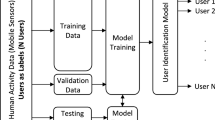Abstract
Nowadays, commonly-used authentication systems for mobile device users, e.g. password checking, face recognition or fingerprint scanning, are susceptible to various kinds of attacks. In order to prevent some of the possible attacks, these explicit authentication systems can be enhanced by considering a two-factor authentication scheme, in which the second factor is an implicit authentication system based on analyzing motion sensor data captured by accelerometers or gyroscopes. In order to avoid any additional burdens to the user, the registration process of the implicit authentication system must be performed quickly, i.e. the number of data samples collected from the user is typically small. In the context of designing a machine learning model for implicit user authentication based on motion signals, data augmentation can play an important role. In this paper, we study several data augmentation techniques in the quest of finding useful augmentation methods for motion sensor data. We propose a set of four research questions related to data augmentation in the context of few-shot user identification based on motion sensor signals. We conduct experiments on a benchmark data set, using two deep learning architectures, convolutional neural networks and Long Short-Term Memory networks, showing which and when data augmentation methods bring accuracy improvements. Interestingly, we find that data augmentation is not very helpful, most likely because the signal patterns useful to discriminate users are too sensitive to the transformations brought by certain data augmentation techniques. This result is somewhat contradictory to the common belief that data augmentation is expected to increase the accuracy of machine learning models.
Access this chapter
Tax calculation will be finalised at checkout
Purchases are for personal use only
Similar content being viewed by others
References
Andriotis, P., Tryfonas, T., Oikonomou, G., Yildiz, C.: A pilot study on the security of pattern screen-lock methods and soft side channel attacks. In: Proceedings of WiSec, pp. 1–6 (2013)
Benegui, C., Ionescu, R.T.: Convolutional neural networks for user identification based on motion sensors represented as images. IEEE Access 8(1), 61255–61266 (2020)
Bărbălău, A., Cosma, A., Ionescu, R.T., Popescu, M.: A generic and model-agnostic exemplar synthetization framework for explainable AI. In: Proceedings of ECML-PKDD (2020)
Ehatisham-ul Haq, M., Azam, M.A., Naeem, U., Amin, Y., Loo, J.: Continuous authentication of smartphone users based on activity pattern recognition using passive mobile sensing. J. Netw. Comput. Appl. 109, 24–35 (2018)
Kingma, D.P., Ba, J.: Adam: a method for stochastic optimization. In: Proceedings of ICLR (2015)
Ku, Y., Park, L.H., Shin, S., Kwon, T.: Draw it as shown: behavioral pattern lock for mobile user authentication. IEEE Access 7, 69363–69378 (2019)
Le Guennec, A., Malinowski, S., Tavenard, R.: Data augmentation for time series classification using convolutional neural networks. In: Proceedings of AALTD Workshop (2016)
Meijering, E.: A chronology of interpolation: from ancient astronomy to modern signal and image processing. Proc. IEEE 90(3), 319–342 (2002)
Neverova, N., et al.: Learning human identity from motion patterns. IEEE Access 4, 1810–1820 (2016)
Shawe-Taylor, J., Cristianini, N.: Kernel Methods for Pattern Analysis. Cambridge University Press, Cambridge (2004)
Shen, C., Yu, T., Yuan, S., Li, Y., Guan, X.: Performance analysis of motion-sensor behavior for user authentication on smartphones. Sensors 16(3), 345 (2016)
Shorten, C., Khoshgoftaar, T.M.: A survey on image data augmentation for deep learning. J. Big Data 6(1), 60 (2019)
Simon, L., Anderson, R.: PIN skimmer: inferring PINs through the camera and microphone. In: Proceedings of SPSM, pp. 67–78 (2013)
Sitová, Z., et al.: HMOG: new behavioral biometric features for continuous authentication of smartphone users. IEEE Trans. Inf. Forensics Secur. 11(5), 877–892 (2016)
Steven Eyobu, O., Han, D.S.: Feature representation and data augmentation for human activity classification based on wearable IMU sensor data using a deep LSTM neural network. Sensors 18(9), 2892 (2018)
Sun, L., Wang, Y., Cao, B., Philip, S.Y., Srisa-An, W., Leow, A.D.: Sequential keystroke behavioral biometrics for mobile user identification via multi-view deep learning. In: Proceedings of ECML-PKDD, pp. 228–240 (2017)
Wang, R., Tao, D.: Context-aware implicit authentication of smartphone users based on multi-sensor behavior. IEEE Access 7, 119654–119667 (2019)
Zhang, Y., Xia, P., Luo, J., Ling, Z., Liu, B., Fu, X.: Fingerprint attack against touch-enabled devices. In: Proceedings of SPSM, pp. 57–68 (2012)
Acknowledgment
The research leading to these results has received funding from the EEA Grants 2014-2021, under Project contract no. EEA-RO-NO-2018-0496.
Author information
Authors and Affiliations
Corresponding author
Editor information
Editors and Affiliations
Rights and permissions
Copyright information
© 2020 Springer Nature Switzerland AG
About this paper
Cite this paper
Benegui, C., Ionescu, R.T. (2020). To Augment or Not to Augment? Data Augmentation in User Identification Based on Motion Sensors. In: Yang, H., Pasupa, K., Leung, A.CS., Kwok, J.T., Chan, J.H., King, I. (eds) Neural Information Processing. ICONIP 2020. Communications in Computer and Information Science, vol 1333. Springer, Cham. https://doi.org/10.1007/978-3-030-63823-8_93
Download citation
DOI: https://doi.org/10.1007/978-3-030-63823-8_93
Published:
Publisher Name: Springer, Cham
Print ISBN: 978-3-030-63822-1
Online ISBN: 978-3-030-63823-8
eBook Packages: Computer ScienceComputer Science (R0)




